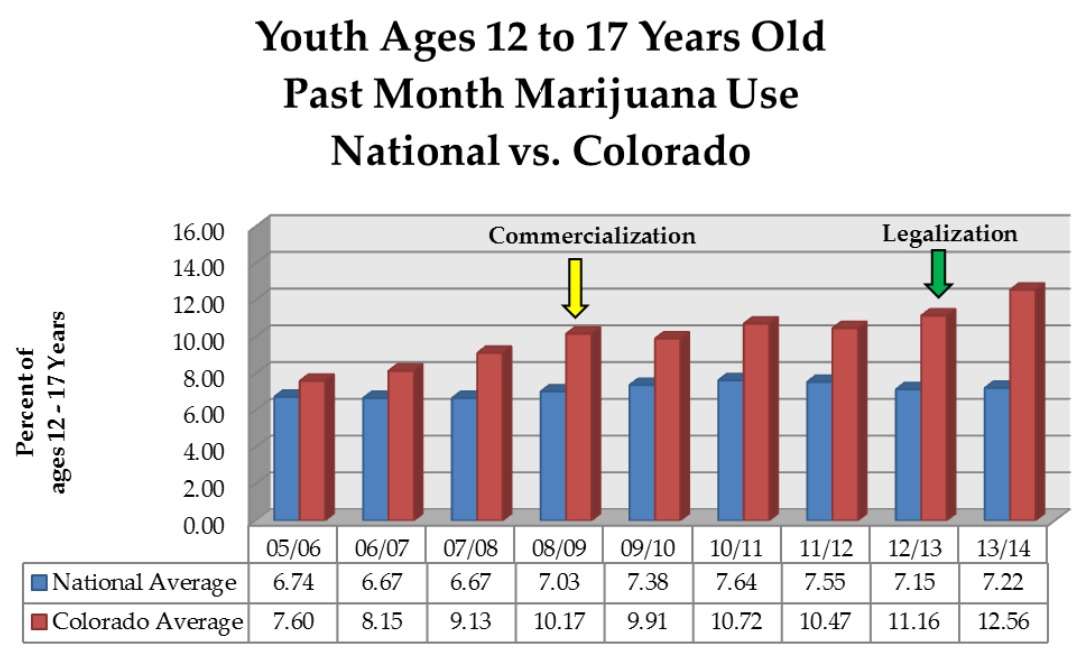Do More Teenagers Smoke Pot When It's Legal?
Contrary to what prohibitionists claim, the numbers from Colorado are equivocal.
Last week Chuck Grassley and Dianne Feinstein, the two oldest members of the U.S. Senate and two of its most enthusiastic drug warriors, held a hearing on the Justice Department's response to marijuana legalization in Colorado and Washington. "When comparing the two-year average before and after legalization," Feinstein, a California Democrat, said in her opening statement, "current marijuana use among 12-to-17-year-olds increased by 20 percent…while the national average decreased by 4 percent. In my book, that's a very big statistic, and [it] tells you a lot."
That comparison, which comes from a report that the Rocky Mountain High Intensity Drug Trafficking Area (RMHIDTA) issued in January, is popular among opponents of legalization. But it does not tell us nearly as much as Feinstein thinks.
RMHIDTA, an anti-drug task force whose annual reports on legalization in Colorado are designed to show what a disastrous mistake it was, provided the numbers cited by Feinstein in an update to its 2015 report. They come from the National Survey on Drug Use and Health (NSDUH), which samples Americans 12 and older. When you focus on teenagers and break the numbers down by state, the samples are quite small, which is why NSDUH pools data for two years at a time.
For 2011-12, the two years before legalization, the rate of past-month marijuana use (a.k.a. "current" use) among 12-to-17-year-olds in Colorado was 10.5 percent. That number rose to 12.6 percent in 2013-14, the first two years in which marijuana was legal for recreational use. "In the two year average (2013/2014) since Colorado legalized recreational marijuana," RMHIDTA says, "youth past month marijuana use increased 20 percent compared to the two year average prior to legalization (2011/2012)."
As it tends to do, RMHIDTA leaves out an important piece of information that weakens its case against legalization: The increase it highlights was not statistically significant. If you look at this NSDUH report from December, you can see that the pre-legalization estimate (10.5 percent) falls within the 95 percent confidence interval for the post-legalization estimate (10.3 percent to 15.2 percent). In other words, given the potential for sampling error, we cannot say with 95 percent confidence (the usual standard) that the increase Feinstein deems "very big" actually happened. The confidence intervals for the state-specific NSDUH numbers are pretty wide, reflecting the small sample sizes, which makes it hard to distinguish real trends from sampling variation.
Another crucial point that RMHIDTA obscures is that the rate of marijuana use among Colorado teenagers was high (compared to other states) and rising well before legalization. In fact, the NSDUH estimate of past-month use rose by 20 percent between 2005-06 and 2007-08—as big as the increase RMHIDTA and Feinstein attribute to legalization. The increase between 2006-07 and 2008-09 was even bigger: 25 percent. That pattern does not fit the story RMHIDTA and Feinstein are telling: that legalizing marijuana for adults 21 and older has already increased underage consumption.

"We've always had a high use rate among youth and adults," Larry Wolk, director of the Colorado Department of Public Health and Environment, told The Denver Post in December. "It's something we've had to contend with, whether or not marijuana is legal. So that's not news. It's easy to get misled by numbers if you don't understand what's behind those numbers."
The NSDUH numbers for Washington, which also legalized marijuana at the end of 2012, further undermine the claim that teenagers are more inclined to smoke pot now because it's legal for adults. The NSDUH estimate of past-month marijuana use by Washington teenagers has been essentially flat in the last few years: 10.1 percent in 2013-14, compared to 9.8 percent in 2012-13 and 9.5 percent in 2011-12.
None of this necessarily means legalization won't lead to an increase in underage cannabis consumption. Legalization advocates like to point out that black-market dealers do not card their customers, while legal marijuana merchants have a strong incentive to do so, because otherwise they can lose their licenses. Hence it is harder for minors to obtain marijuana directly from retailers in a legal market. But it may be easier for them to obtain marijuana indirectly from adult buyers, whether by swiping it on the sly or by cadging it from older siblings or friends. When adults can legally buy marijuana, there may be more opportunities for such diversion.
It is premature to draw any conclusions about the significance of that phenomenon, since legal recreational sales in Colorado and Washington did not begin until 2014. In other words, it is plausible to predict that marijuana legalization will boost underage consumption, but prohibitionists who suggest it is already happening are getting ahead of the evidence.
Even if the prohibitionists eventually prove to be right about underage consumption, the potential for diversion to minors hardly counts as a decisive argument against legalizing marijuana, any more than it counted as a decisive argument against legalizing alcohol. If Americans were denied access to everything that is appropriate only for adults, we would all be reduced to the status of children.
This article originally appeared at Forbes.com.




Show Comments (36)